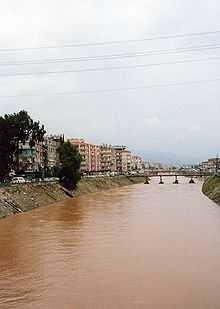Orontes River

- See Orontid dynasty for the Armenian kings and satraps called Orontes.
The Orontes (/əˈrɒntiz/; Ὀρόντης) or Asi (Arabic: العاصي, ‘Āṣī; Turkish: Asi) is a river of Lebanon, Syria and Turkey.
It was anciently the chief river of the Levant, also called Draco, Typhon and Axius. The last was a native form, from whose revival, or continuous employment in native speech, has preceded the modern name ‘Āṣī ("rebel"), because the river flows from the south to the north unlike the rest of the rivers in the region[citation needed].
Etymology
The name Orontes is the Hellenized form of the Iranian name, Haeravanta, meaning "that of grandeur." There are a great number of rivers and mountains carrying a variety of this name all over where the ancient and modern Iranian peoples have settled, from the Pamirs to Anatolia and the Levant. Rivers like the Arvand and the Alvand (Iraq), mountains like Alvand (Iran), and the Iranian Armenian dynasty, the Orontids (a dynasty that traces its founding originator to Bactria/Balkh in the Iranian northern Afghanistan). In its Arabized form, Halwan/Hilwan, the name is carried by towns and villages from Egypt to Iran. These all carry this ancient Iranian compound name in its various form, standing for grandeur and greatness.
Course

The Orontes rises in the great springs of Labweh on the east side of the Beqaa Valley, very near the fountains of the southward-flowing Litani, and it runs due north, parallel with the coast, falling 2000 feet (600 m) through a rocky gorge. Leaving this it expands into the Lake of Homs, having been dammed back in antiquity. The valley now widens out into the rich district of Hamah (Hamaih-Epiphaneia), below which lie the broad meadow-lands of Amykes, containing the sites of ancient Apamea and Larissa. This central Orontes valley ends at the rocky barrier of Jisr al-Hadid, where the river is diverted to the west, and the plain of Antioch opens.
Two large tributaries from the north, the Afrin and Karasu, here reach it through the former Lake of Antioch, which is now drained through an artificial channel (Nahr al-Kowsit). Passing north of the modern Antakya (ancient Antioch) the Orontes plunges southwest into a gorge (compared by the ancients to Tempe), and falls 150 feet (50 m) in 10 miles (16 km) to the sea just south of the little port of Samandağı (former Suedia, in antiquity Seleucia Pieria), after a total course of 150 miles (240 km).
History

Mainly unnavigable and of little use for irrigation, the Orontes derives its historical importance solely from the convenience of its valley for traffic from north to south; roads from the north and northeast, converging at Antioch, follow the course of the stream up to Homs where they built the Al-Rastan Dam, where they fork to Damascus and to Syria and the south; and along its valley have passed the armies and traffic bound to and from Egypt in all ages. On the Orontes was fought the Battle of Kadesh during the reign of Ramesses II (1279–1213 BC). By the Orontes the Battle of Qarqar was fought in 853 BC, when the army of Assyria, led by king Shalmaneser III, encountered an allied army of 12 kings led by Hadadezer of Damascus. In 637 A.D the Battle of Iron bridge was fought between the forces of the Rashidun Caliphate and the Byzantine Empire near the Iron bridge on the river made by Romans.
The Orontes has long been a boundary marker. For the Egyptians it marked the northern extremity of Amurru, east of Phoenicia. For the Crusaders in the 12th century, the Orontes River became the permanent boundary between the Principality of Antioch and that of Aleppo.
The French writer Maurice Barrès (1862–1923) wrote about the river in his Un Jardin sur l'Oronte.
See also
References
 This article incorporates text from a publication now in the public domain: Chisholm, Hugh, ed. (1911). Encyclopædia Britannica (11th ed.). Cambridge University Press
This article incorporates text from a publication now in the public domain: Chisholm, Hugh, ed. (1911). Encyclopædia Britannica (11th ed.). Cambridge University Press- Joseph Fitchett and McAdams Deford, A River Called Rebel, 1973, Saudi Aramco World
Coordinates: 35°15′N 36°35′E / 35.250°N 36.583°E
| ||||||||||||||||||||
| ||||||||||||||||||||||||||||||||||||||||||||||||||
Pop-up map of the Orontes River available at: http://www.sciencedirect.com/science/article/pii/S0168583X11005088